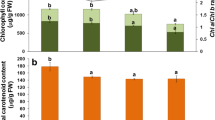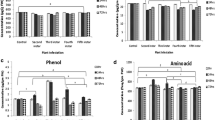Abstract
Plants respond to herbivorous attack through a defence system that includes structural barriers, release of toxic chemicals, and attraction of natural enemies of the target pests, etc. In this study, plants of Bougainvillea glabra Choisy (Nyctaginaceae) were artificially infested with the obligate phloem-feeding insect pest Phenacoccus peruvianus Granara de Willink (Hemiptera: Pseudococcidae) and compared with control uninfested plants. Leaf samples were collected at 2, 6, 12, 24, 48, 96 and 144 h after infestation to monitor the plant response. Proline (Pro), malondialdehyde (MDA), chlorophyll (Chla, Chlb, and Chla+b), and total carotenoid (Car) contents, as well as the activities of catalase (CAT) and phenylalanine ammonia-lyase (PAL) antioxidant enzymes, were measured at each sampling time to better understand the mechanism of plant defences. Proline content was the highest at 2 h after infestation and remained high throughout the experiment, while MDA content differed significantly only at 12 h after infestation. The value of chlorophyll was higher in the control plants, indicating that insect attack seriously compromised the photosynthetic activity of infected plants. Enzymatic activities showed significant increases, CAT of about 50% after 24 h and PAL of about 43% after 6 h. This study will be useful for understanding Bougainvillea plant defence against mealybugs and for showing that this ornamental species is able to activate enzymatic and molecular mechanisms in response to insect attack.



Similar content being viewed by others
Abbreviations
- CAT:
-
Catalase
- Chla, Chlb and Chla+b :
-
Chlorophyll a, b and total
- MDA:
-
Malondialdehyde
- Pro:
-
Proline
- PAL:
-
Phenylalanine ammonia-lyase
- ROS:
-
Reactive oxygen species
References
Aebi H (1984) Catalase in vitro. Method Enzymol 105:121–130. doi:10.1016/S0076-6879(84)05016-3
Aguilera J, Bischof K, Karsten U, Hanelt D, Wiencke C (2002) Seasonal variation in ecophysiological patterns in macroalgae from an Arctic fjord. II. Pigment accumulation and biochemical defence systems against high light stress. Mar Biol 140:1087–1095. doi:10.1007/s00227-002-0792-y
Ahmad P, John R, Sarwat M, Umar S (2008) Responses of proline, lipid peroxidation and antioxidative enzymes in two varieties of Pisum sativum L. under salt stress. Int J Plant Prod 2:353–366
Barah P, Bones AM (2015) Multidimensional approaches for studying plant defence against insects: from ecology to omics and synthetic biology. J Exp Bot 66:479–493. doi:10.1093/jxb/eru489
Behmer ST, Joern A (1994) The influence of proline on diet selection—sex-specific feeding preferences by the grasshoppers Ageneotettix deorum and Phoetaliotes nebrascensis (orthoptera, acrididae). Oecologia 98:76–82. http://www.jstor.org/stable/4220669
Beltrà A, Soto A, Germain J-F, Matile-Ferrero D, Mazzeo G, Pellizzari G, Russo A, Franco J, Williams DJ (2010) The Bougainvillea Mealybug, a rapid invader from South America to Europe (Phenacoccus peruvianus Granara de Willink, 2007). XII ISSIS. Creta 6-10 Aprile 2010. Entomologia hellenica 19:137–143
Buntin GD, Gilbertz DA, Oetting RD (1993) Chlorophyll loss and gas exchange in tomato leaves after feeding injury by Bemisia tabaci (Homoptera: Aleyrodidae). J Econ Entomol 86:517–522. doi:10.1093/jee/86.2.517
Buntin GD, Braman SK, Gilhertz DA, Phillips DV (1996) Chlorosis, photosynthesis, and transpiration of azalea leaves after azalea lace bug (Heteroptera: Tingidae) feeding injury. J Econ Entomol 89:990–995
Catalayud P-A, Le Rü B (2006) Cassava-Mealybug Interactions. IRD Éditions, Paris. ISBN 978-2-7099-1614-1
Cottrell TE, Wood BW, Ni X (2009) Chlorotic feeding injury by the black pecan aphid (Hemiptera: Aphididae) to pecan foliage promotes aphid settling and nymphal development. Environ Entomol 38:411–416
Davey M, Stals E, Panis B, Keulemans J, Swennen R (2005) High-throughput determination of malondialdehyde in plant tissues. Anal Biochem 347:201–207. doi:10.1016/j.ab.2005.09.041
Dixon RA, Paiva NL (1995) Stress-induced phenylpropanoid metabolism. Plant Cell 7:1085–1097. doi:10.1105/tpc.7.7.1085
Fernandes FL, Picanço MC, Gontijo PC, de Sena Fernandes ME, Pereira EJG, Semeão AA (2011) Induced responses of Coffea arabica to attack of Coccus viridis stimulate locomotion of the herbivore. Entomol Exp Appl 139:120–127. doi:10.1111/j.1570-7458.2011.01113.x
Foyer CH, Noctor G (2005) Oxidant and antioxidant signalling in plants: a re-evaluation of the concept of oxidative stress in a physiological context. Plant Cell Environ 28:1056–1071. doi:10.1104/pp.110.166181
Gade G, Auerswald L (2002) Beetles’ choice—proline for energy output: control by AKHs. Comp Biochem Physiol B 132:117–129. doi:10.1016/S1096-4959(01)00541-3
Gibon Y, Sulpice R, Larher F (2000) Proline accumulation in conola leaf discs subjected to osmotic stress is related to the loss of chlorophylls and to the decrease of mitochondrial activity. Physiol Plant 110:469–476. doi:10.1111/j.1399-3054.2000.1100407.x
Golan K, Rubinowska K, Górska-Drabik E (2013) Physiological and biochemical responses on fern Nephrolepis biserrata (Sw.) Schott. to Coccus hesperidum L. infestation. Acta Biol Cracov Ser Bot 55:1–6. doi:10.2478/abcsb-2013-0007
Golan K, Rubinowska K, Kmieć K, Kot I, Górska-Drabik E, Łagowska B, Michałek W (2015) Impact of scale insect infestation on the content of photosynthetic pigments and chlorophyll fluorescence in two host plant species. Arthropod Plant Interact 9:55–65. doi:10.1007/s11829-014-9339-7
Hayat S, Hayat Q, Alyemeni MN, Wani AS, Pichtel J, Ahmad A (2012) Role of proline under changing environments. Plant Signal Behav 7:1456–1466
Heng-Moss TM, Ni X, Macedo T, Markwell JP, Baxendale FP, Quisenberry SS, Tolmay V (2003) Comparison of chlorophyll and carotenoid concentrations among Russian wheat aphid (Homoptera: Aphididae)-infested wheat isolines. J Econ Entomol 96:475–481. doi:10.1603/0022-0493-96.2.475
Hu ZH, Shen YB, Shen FY, Su XH (2009) Effects of feeding Clostera anachoreta on hydrogen peroxide accumulation and activities of peroxidase, catalase, and ascorbate peroxidase in Populus simonii × P. pyramidalis ‘Opera 8277’ leaves. Acta Physiol Plant 31:995–1002
Huang F, Zhang JM, Zhang PJ, Lu YB (2013) Reproduction of the solenopsis mealybug, Phenacoccus solenopsis: males play an important role. J Insect Sci 13:137. doi:10.1673/031.013.13701
Huxley A, Griffths M, Levy M (1999) The New Royal Horticultural Society Dictionary of gardening. The Macmillan Press Limited, London
Kessler A, Baldwin IT (2002) Plant responses to insect herbivory: the emerging molecular analysis. Annu Rev Plant Biol 53:299–328. doi:10.1146/annurev.arplant.53.100301.135207
Khandaker MM, Faruq G, Rahman MM, Sofian-Azirun M, Boyce AN (2013) The influence of 1-triacontanol on the growth, flowering, and quality of potted bougainvillea plants (Bougainvillea glabra var.“Elizabeth Angus”) under natural conditions. Sci World J 2013(308651):12. doi:10.1155/2013/308651
Kmieć K, Kot I, Rubinowska K, Łagowska B, Golan K, Górska-Drabik E (2014) Physiological reaction of Phalaenopsis x hybridum “Innocence” on Pseudococcus longispinus (Targioni Tozzetti) feeding. Acta Sci Pol Hortorum Cultus 13(3):85–95
Leonardi C, Romano D (2003) Caratteristiche di tipi di buganvillea diffusi nella Sicilia orientale. Italus Hortus 10(4):234–237
Li G, Wan S, Zhou J, Yang Z, Qin P (2010) Leaf chlorophyll fluorescence, hyperspectral reflectance, pigments content, malondialdehyde and proline accumulation responses of castorbean (Ricinus communis L.) seedlings to salt stress levels. Ind Crop Prod 31:13–19. doi:10.1016/j.indcrop.2009.07.015
Maffei ME, Mithöfer A, Arimura GI, Uchtenhagen H, Bossi S, Bertea CM, Cucuzza LS, Novero M, Volpe V, Quadro S, Boland W (2006) Effects of feeding Spodoptera littoralis on Lima bean leaves. III. Membrane depolarization and involvement of hydrogen peroxide. Plant Physiol 140:1022–1035. doi:10.1104/pp.105.071993
Maffei ME, Mithöfer A, Boland W (2007) Insect feeding on plants: rapid signals and responses preceding the induction of phytochemical release. Phytochemistry 68:2946–2959. doi:10.1016/j.phytochem.2007.07.016
Malumphy C, Eyre D (2011) Plant fact sheet: Bougainvillea Mealybug Phenacoccus peruvianus. The Food and Environment Research Agency (FERA) 1–4 http://fera.co.uk/news/resources/documents/pests-disease-bougainvillea.pdf
Mansoor MF (2000) Nitrogen containing compounds and adaptation of plants to salinity stress. Biol Plant 43:491–500. doi:10.1023/A:1002873531707
Meyer ST, Roces F, Wirth R (2006) Selecting the drought stressed: effects of plant stress on intraspecific and within-plant herbivory patterns of the leaf-cutting ant Atta colombica. Funct Ecol 20:973–981. doi:10.1111/j.1365-2435.2006.01178.x
Mishra M, Lomate PR, Joshi RS, Punekar SA, Gupta VS, Giri AP (2015) Ecological turmoil in evolutionary dynamics of plant–insect interactions: defense to offence. Planta 242:761–771. doi:10.1007/s00425-015-2364-7
Mozzetti C, Ferraris L, Tamietti G, Matta A (1995) Variation in enzyme activities in leaves and cell suspensions as markers of incompatibility in different Phytophthora pepper interactions. Physiol Mol Plant P 46:95–107. doi:10.1006/pmpp.1995.1008
Ni X, Quisenberry SS, Heng-Moss T, Markwell J, Higley L, Baxendale F, Sarath G, Klucas R (2002) Dynamic change in photosynthetic pigments and chlorophyll degradation elicited by cereal aphid feeding. Entomol Exp Appl 105:43–53
Porra RJ, Thompson WA, Kriedelman PE (1989) Determination of accurate extraction and simultaneously equation for assaying chlorophyll a and b extracted with different solvents: verification of the concentration of chlorophyll standards by atomic absorption spectroscopy. Biochim Biophys Acta 975:384–394
Shafique S, Ahmada A, Shafiquea S, Anjuma T, Akrama W, Bashir Z (2014) Determination of molecular and biochemical changes in cotton plants mediated by Mealybug. NJAS—Wageningen J Life Sci 70–71:39–45. doi:10.1016/j.njas.2014.05.001
Sharma P, Bhushan Jha A, Shanker Dubey R, Pessarakli M (2012) Reactive oxygen species, oxidative damage, and antioxidative defense mechanism in plants under stressful conditions. J Bot 2012:1–26. doi:10.1155/2012/217037
Simbiken NA, Cooper PD, Powell KS (2015) Development and feeding effect of frosted scale Parthenolecanium pruinosum Cocquillet (Hemiptera: Coccidae) on selected Vitis vinifera L. cultivars. Aust J Grape Wine Res 21:451–457. doi:10.1111/ajgw.12154
Stam JM, Kroes A, Li Y, Gols R, van Loon JJA, Poelman EH, Dicke M (2014) Plant interactions with multiple insect herbivores: from community to genes. Annu Rev Plant Biol 65:689–713. doi:10.1146/annurev-arplant-050213-035937
Van Poecke RMP, Dicke M (2004) Indirect defence of plants against herbivores: using Arabidopsis thaliana as a model plant. Plant Biol 6:387–401. doi:10.1055/s-2004-820887
War AR, Paulraj MG, Ignacimuthu S, Sharma HC (2013) Defensive responses in groundnut against chewing and sap-sucking insects. J Plant Growth Regul 32:259–272. doi:10.1007/s00344-012-9294-4
Yang CM, Chang KW, Yin MH, Huang HM (1998) Methods for the determination of chlorophylls and their derivatives. Taiwania 43:116–122
Zhou FR, Wang JX, Yang N (2015) Growth responses, antioxidant enzyme activities and lead accumulation of Sophora japonica and Platycladus orientalis seedlings under Pb and water stress. Plant Growth Regul 75:383–389. doi:10.1007/s10725-014-9927-7
Author information
Authors and Affiliations
Corresponding author
Additional information
Handling Editor: Ritu Chaudhary.
Rights and permissions
About this article
Cite this article
Abbate, C., Toscano, S., Arcidiacono, R. et al. Induced responses of Bougainvillea glabra Choisy (Nyctaginaceae) against Phenacoccus peruvianus Granara de Willink (Hemiptera: Pseudococcidae) attack: preliminary results. Arthropod-Plant Interactions 12, 41–48 (2018). https://doi.org/10.1007/s11829-017-9550-4
Received:
Accepted:
Published:
Issue Date:
DOI: https://doi.org/10.1007/s11829-017-9550-4




